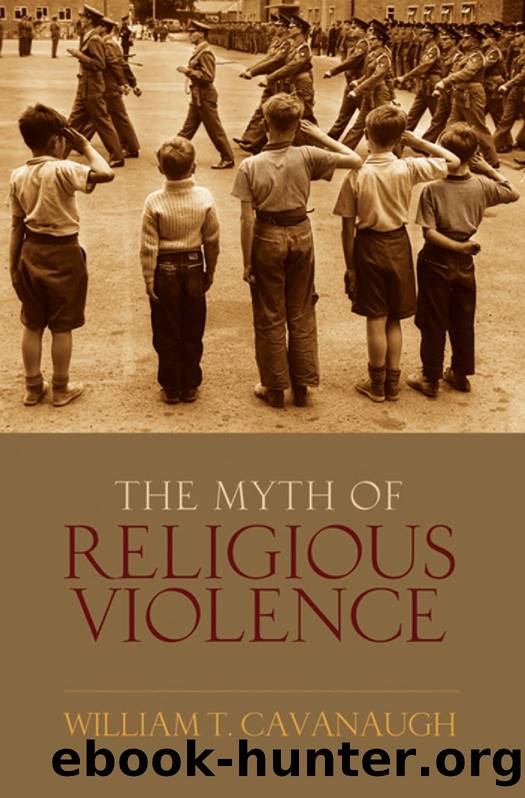The Myth of Religious Violence by William T. Cavanaugh

Author:William T. Cavanaugh [Cavanaugh, William T.]
Language: eng
Format: epub
Tags: ISBN-13:, 9780195385045, Atheism, Religion, Philosophy
ISBN: 9780195385045
Google: NBXnj1W2ShwC
Amazon: 0195385047
Publisher: Oxford University Press
Published: 2009-09-02T18:30:00+00:00
We will now see how each of these components stands up to recorded history. This is important, given that the tellings of the narrative we examined above tend not to look very closely at history. Toulminâs, Skinnerâs, and Pocockâs books contain scattered references in the notes to contemporary histories of the religious wars. None of the other figures cites, either in the main text or the footnotes, any work by any historian of the European wars of religion.
The Historical Record
(A) Combatants Opposed Each Other Based on Religious Difference
The myth of the wars of religion is an uncomplicated tale of violence between religious groups who held to different theological doctrines. Historical records of these wars, however, show many examples of members of the same church killing each other and members of different churches collaborating:
⢠If there truly were a war of all sects against all, one would expect that war would have broken out soon after Europe split into Catholic and Protestant factions. However, between the time that Martin Luther nailed his Ninety-Five Theses to the church door at Wittenberg in 1517 and the outbreak of the first commonly cited religious warâthe Schmalkaldic War of 1546-1547âalmost thirty years would pass. The Catholic prosecutor of the Schmalkaldic War, Holy Roman emperor
Charles V, spent much of the decade following Lutherâs excommunication in 1520 at war not against Lutherans, but against the pope.
As Richard Dunn points out, âCharles Vâs soldiers sacked Rome, not Wittenberg, in 1527, and when the papacy belatedly sponsored a reform program, both the Habsburgs and the Valois refused to endorse much of it, rejecting especially those Trentine decrees which encroached on their sovereign authority.â93 The wars of the 1520s were part of the ongoing struggle between the pope and the emperor for control over Italy and over the church in German territories.94
⢠The early decades of the Reformation saw Catholic France in frequent wars against the Catholic emperor. The wars began in 1521, 1527, 1536, 1542, and 1552; most lasted two to three years.95 Charles V was at war twenty-three of the forty-one years of his reign, sixteen of them against France.96 Although most of these wars predate what are commonly called the wars of religion, they come in the wake of the Reformation and underscore the fact that the first decades of religious difference in Europe did not produce war between sects. War continued to be based on other factors.
⢠In a similar vein, starting in 1525, Catholic France made frequent alliances with the Muslim Turks against Catholic emperor Charles V.97
⢠Until the Schmalkaldic War of 1546-1547, the Protestant princes of the Holy Roman Empire generally supported the Catholic emperor in his wars against France. In 1544, Charles granted wide control to the Protestant princes over the churches in their realms in exchange for military support against France.98
⢠The first religious war of Charles V against the Schmalkaldic League found a number of important Protestant princes on Charlesâs side, including Duke Moritz of Saxony, the Margrave Albrecht-Alcibiades of Brandenburg,99 and the Margrave Hans of Kustrin.
Download
This site does not store any files on its server. We only index and link to content provided by other sites. Please contact the content providers to delete copyright contents if any and email us, we'll remove relevant links or contents immediately.
The Lost Art of Listening by Michael P. Nichols(7347)
Why I Am Not A Calvinist by Dr. Peter S. Ruckman(4066)
The Rosicrucians by Christopher McIntosh(3431)
Wicca: a guide for the solitary practitioner by Scott Cunningham(3093)
Signature in the Cell: DNA and the Evidence for Intelligent Design by Stephen C. Meyer(2986)
Real Sex by Lauren F. Winner(2925)
The Holy Spirit by Billy Graham(2829)
To Light a Sacred Flame by Silver RavenWolf(2730)
The End of Faith by Sam Harris(2651)
The Gnostic Gospels by Pagels Elaine(2429)
Waking Up by Sam Harris(2348)
Nine Parts of Desire by Geraldine Brooks(2293)
Jesus by Paul Johnson(2260)
Devil, The by Almond Philip C(2234)
The God delusion by Richard Dawkins(2211)
Heavens on Earth by Michael Shermer(2204)
Kundalini by Gopi Krishna(2108)
Chosen by God by R. C. Sproul(2076)
The Nature of Consciousness by Rupert Spira(1999)
